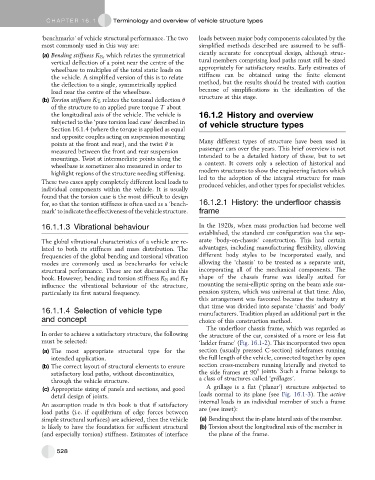Page 519 - Automotive Engineering Powertrain Chassis System and Vehicle Body
P. 519
CHAP TER 1 6. 1 Terminology and overview of vehicle structure types
‘benchmarks’ of vehicle structural performance. The two loads between major body components calculated by the
most commonly used in this way are: simplified methods described are assumed to be suffi-
ciently accurate for conceptual design, although struc-
(a) Bending stiffness K B , which relates the symmetrical
tural members comprising load paths must still be sized
vertical deflection of a point near the centre of the
appropriately for satisfactory results. Early estimates of
wheelbase to multiples of the total static loads on
stiffness can be obtained using the finite element
the vehicle. A simplified version of this is to relate
the deflection to a single, symmetrically applied method, but the results should be treated with caution
load near the centre of the wheelbase. because of simplifications in the idealization of the
structure at this stage.
(b) Torsion stiffness K T , relates the torsional deflection q
of the structure to an applied pure torque T about
the longitudinal axis of the vehicle. The vehicle is 16.1.2 History and overview
subjected to the ‘pure torsion load case’ described in of vehicle structure types
Section 16.1.4 (where the torque is applied as equal
and opposite couples acting on suspension mounting
points at the front and rear), and the twist q is Many different types of structure have been used in
measured between the front and rear suspension passenger cars over the years. This brief overview is not
mountings. Twist at intermediate points along the intended to be a detailed history of these, but to set
wheelbase is sometimes also measured in order to a context. It covers only a selection of historical and
highlight regions of the structure needing stiffening. modern structures to show the engineering factors which
led to the adoption of the integral structure for mass
These two cases apply completely different local loads to produced vehicles, and other types for specialist vehicles.
individual components within the vehicle. It is usually
found that the torsion case is the most difficult to design
for, so that the torsion stiffness is often used as a ‘bench- 16.1.2.1 History: the underfloor chassis
mark’toindicatetheeffectivenessofthevehiclestructure. frame
16.1.1.3 Vibrational behaviour In the 1920s, when mass production had become well
established, the standard car configuration was the sep-
The global vibrational characteristics of a vehicle are re- arate ‘body-on-chassis’ construction. This had certain
lated to both its stiffness and mass distribution. The advantages, including manufacturing flexibility, allowing
frequencies of the global bending and torsional vibration different body styles to be incorporated easily, and
modes are commonly used as benchmarks for vehicle allowing the ‘chassis’ to be treated as a separate unit,
structural performance. These are not discussed in this incorporating all of the mechanical components. The
shape of the chassis frame was ideally suited for
book. However, bending and torsion stiffness K B and K T
influence the vibrational behaviour of the structure, mounting the semi-elliptic spring on the beam axle sus-
particularly its first natural frequency. pension system, which was universal at that time. Also,
this arrangement was favoured because the industry at
that time was divided into separate ‘chassis’ and ‘body’
16.1.1.4 Selection of vehicle type manufacturers. Tradition played an additional part in the
and concept choice of this construction method.
The underfloor chassis frame, which was regarded as
In order to achieve a satisfactory structure, the following the structure of the car, consisted of a more or less flat
must be selected: ‘ladder frame’ (Fig. 16.1-2). This incorporated two open
(a) The most appropriate structural type for the section (usually pressed C-section) sideframes running
intended application. the full length of the vehicle, connected together by open
(b) The correct layout of structural elements to ensure section cross-members running laterally and riveted to
satisfactory load paths, without discontinuities, the side frames at 90 joints. Such a frame belongs to
through the vehicle structure. a class of structures called ‘grillages’.
(c) Appropriate sizing of panels and sections, and good A grillage is a flat (‘planar’) structure subjected to
detail design of joints. loads normal to its plane (see Fig. 16.1-3). The active
internal loads in an individual member of such a frame
An assumption made in this book is that if satisfactory
load paths (i.e. if equilibrium of edge forces between are (see inset):
simple structural surfaces) are achieved, then the vehicle (a) Bending about the in-plane lateral axis of the member.
is likely to have the foundation for sufficient structural (b) Torsion about the longitudinal axis of the member in
(and especially torsion) stiffness. Estimates of interface the plane of the frame.
528

